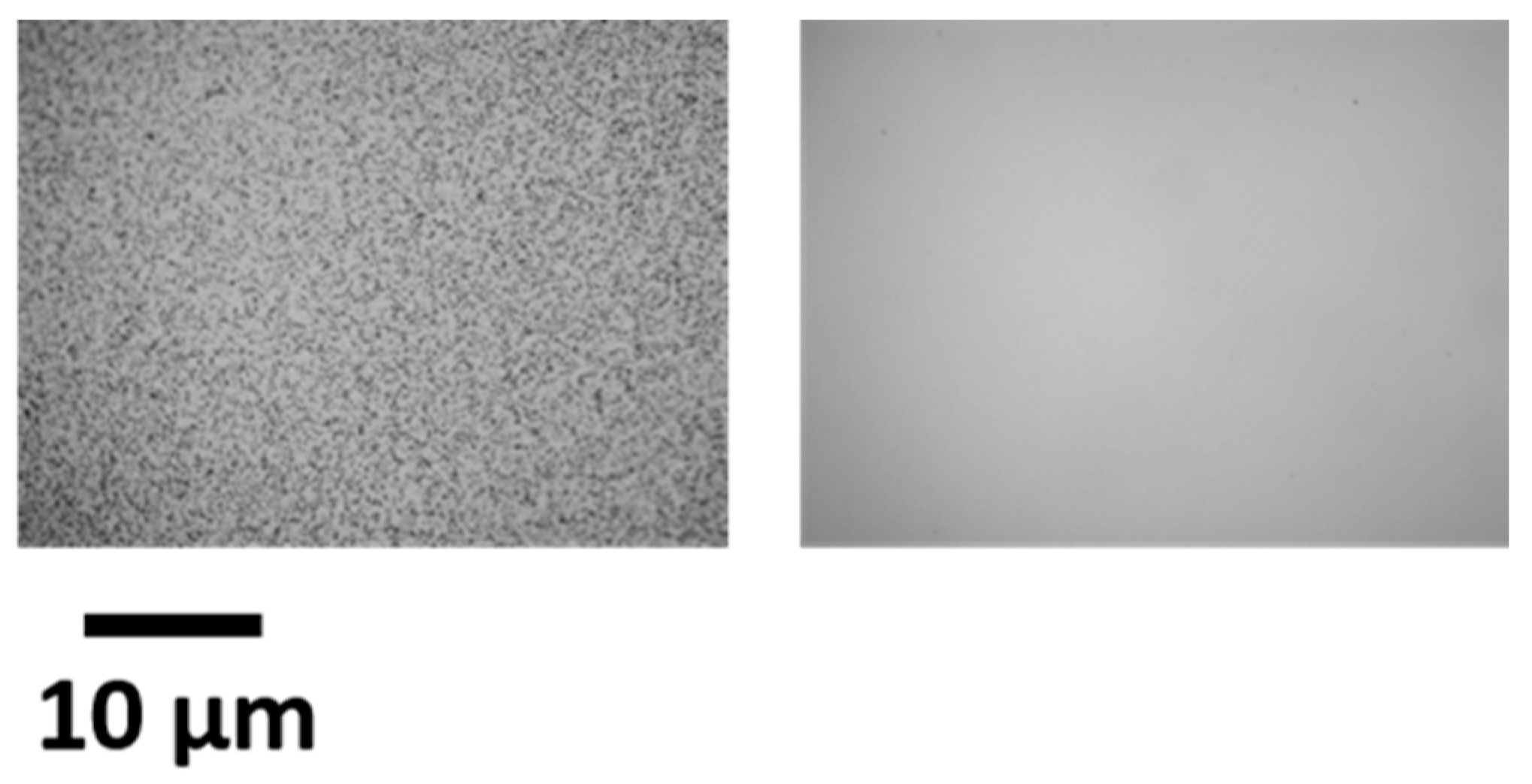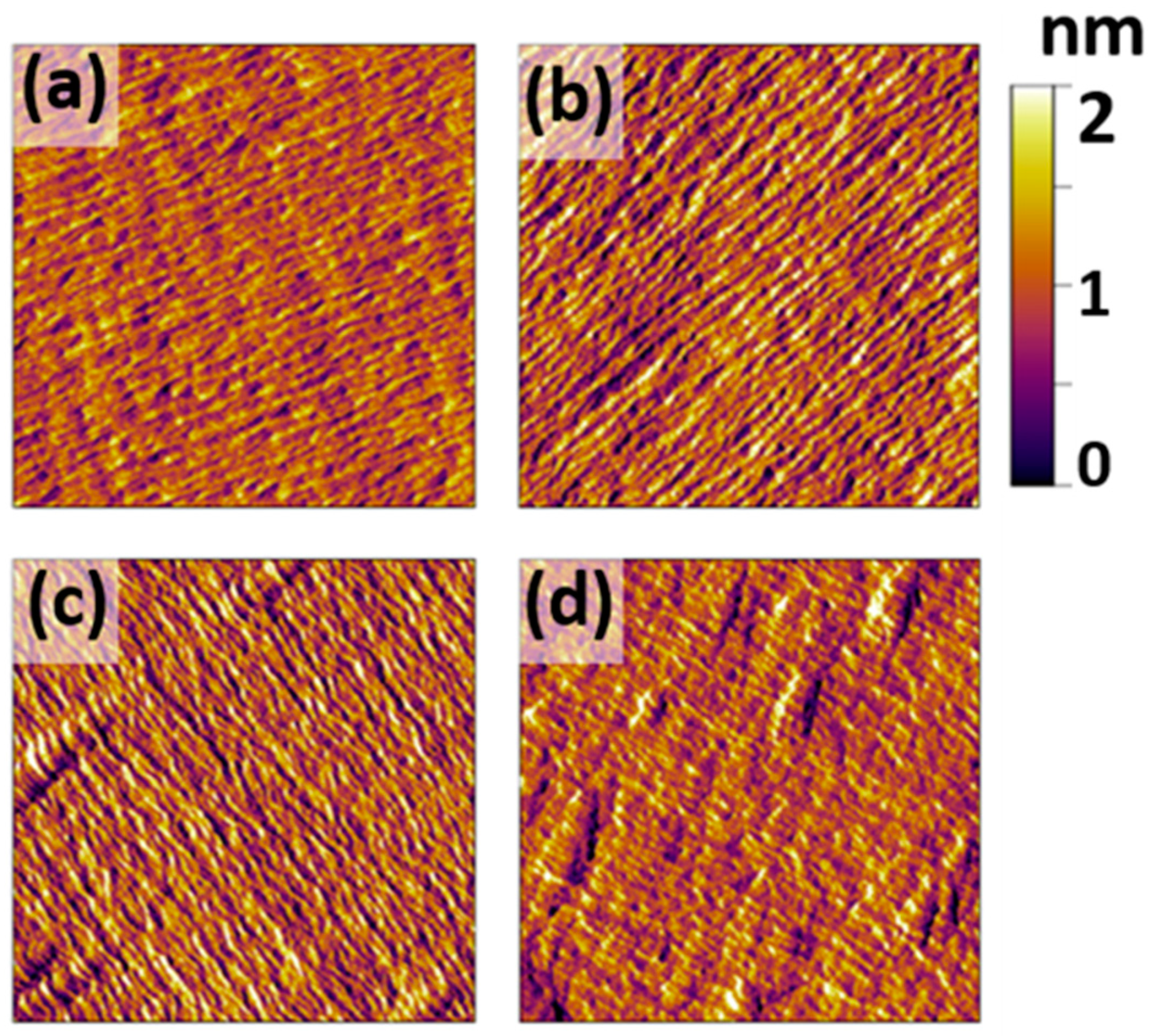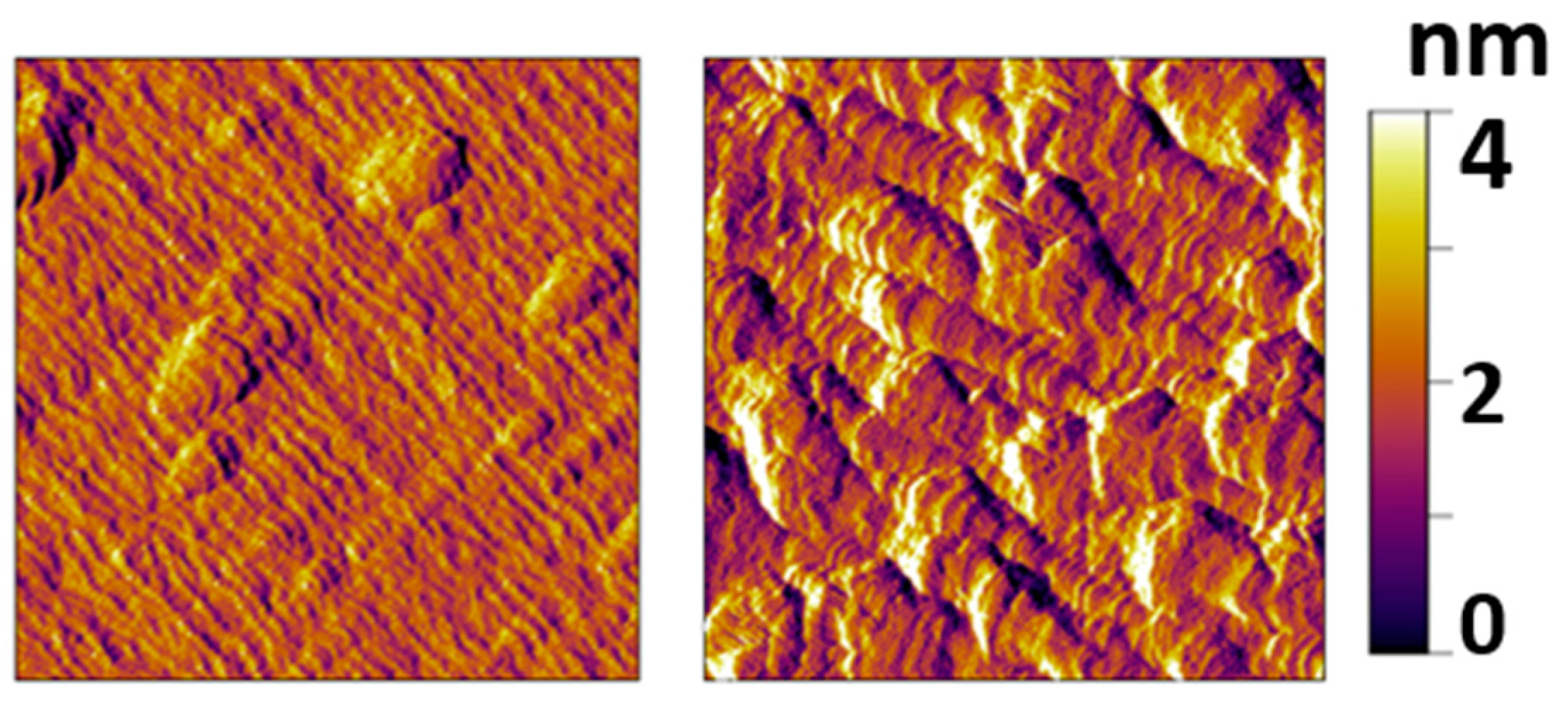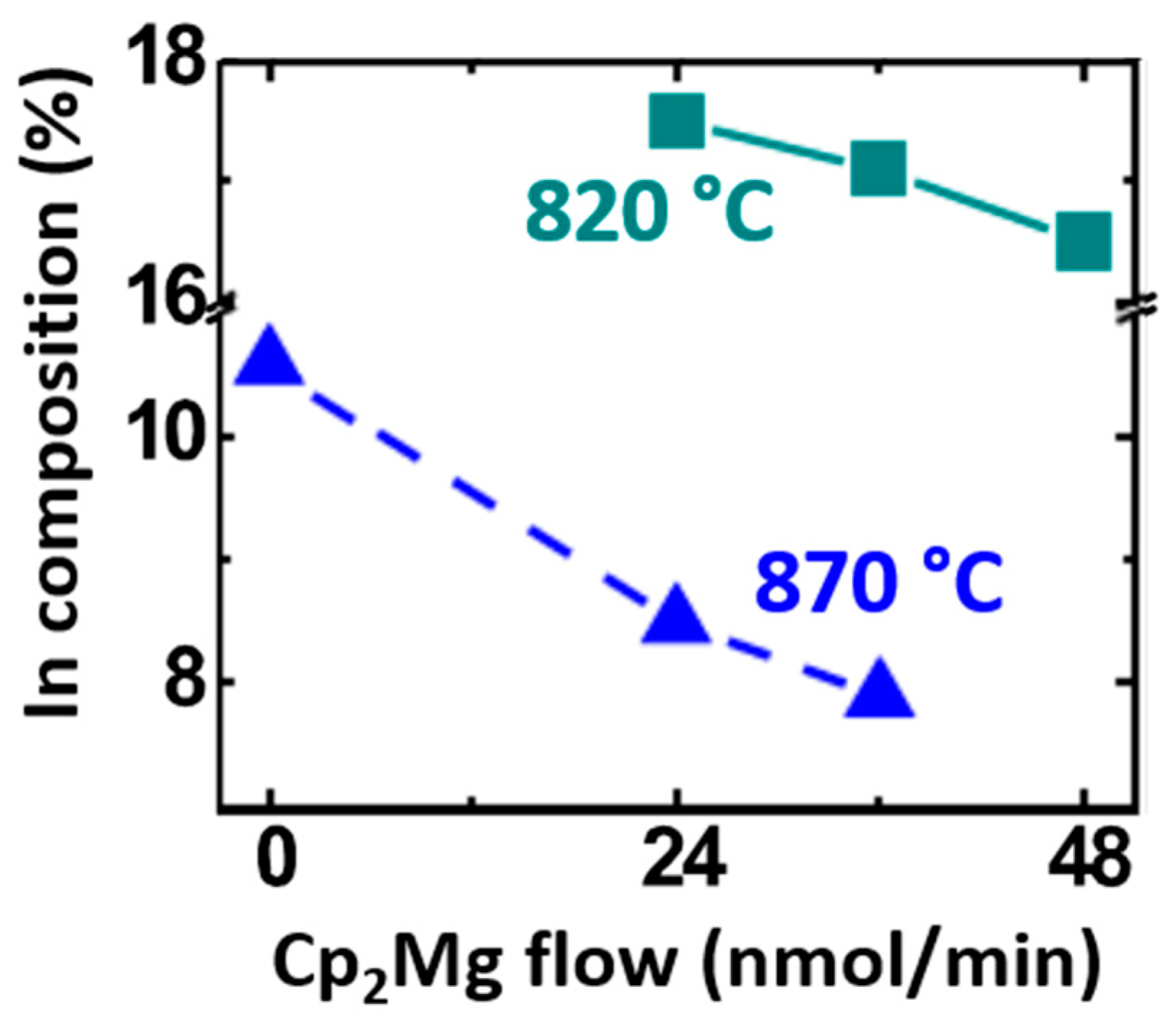Metal Organic Vapor Phase Epitaxy of Thick N-Polar InGaN Films
Abstract
1. Introduction
2. Materials and Methods
3. Results and Discussion
4. Conclusions
Author Contributions
Funding
Conflicts of Interest
References
- Langer, T.; Kruse, A.; Ketzer, F.A.; Schwiegel, A.; Hoffmann, L.; Jönen, H.; Bremers, H.; Rossow, U.; Hangleiter, A. Origin of the “green gap”: Increasing nonradiative recombination in indium-rich GaInN/GaN quantum well structures. Phys. Status Solidi C 2011, 8, 2170–2172. [Google Scholar] [CrossRef]
- Nakamura, S.; Senoh, M.; Iwasa, N.; Nagahama, S. Superbright Green InGaN Single-Quantum-Well-Structure Light-Emitting Diodes. Jpn. J. Appl. Phys. 1995, 34, L1332. [Google Scholar] [CrossRef]
- Chichibu, S.; Azuhata, T.; Sota, T.; Nakamura, S. Spontaneous emission of localized excitons in InGaN single and multiquantum well structures. Appl. Phys. Lett. 1996, 69, 4188–4190. [Google Scholar] [CrossRef]
- Narukawa, Y.; Kawakami, Y.; Funato, M.; Fujita, S.; Fujita, S.; Nakamura, S. Role of self-formed InGaN quantum dots for Role of self-formed InGaN quantum dots for emitting at 420 nm. Appl. Phys. Lett. 1997, 70, 981. [Google Scholar] [CrossRef]
- Mukai, T.; Narimatsu, H.; Nakamura, S. Amber InGaN-Based Light-Emitting Diodes Operable at High Ambient Temperatures. Jpn. J. Appl. Phys. 1998, 37, L479. [Google Scholar] [CrossRef]
- Gupta, C.; Tsukada, Y.; Romanczyk, B.; Pasayat, S.S.; James, D.-A.; Ahmadi, E.; Keller, S.; Mishra, U.K. First demonstration of improvement in hole conductivity in c-plane III-Nitrides through application of uniaxial strain. Jpn. J. Appl. Phys. 2019, 58, 030908. [Google Scholar] [CrossRef]
- Li, W.; Pasayat, S.; Guidry, M.; Romanczyk, B.; Zheng, X.; Gupta, C.; Hatui, N.; Keller, S.; Mishra, U.K. First experimental demonstration and analysis of electrical transport characteristics of a GaN-based HEMT with a relaxed InGaN channel. Semicond. Sci. Technol. 2020, 35, 075007. [Google Scholar] [CrossRef]
- Dreyer, C.E.; Janotti, A.; van de Walle, C.G. Effects of strain on the electron effective mass in GaN and AlN. Appl. Phys. Lett. 2013, 102, 142105. [Google Scholar] [CrossRef]
- Nakamura, S.; Senoh, M.; Iwasa, N.; Nagahama, S. High-Brightness InGaN Blue, Green and Yellow Light-Emitting Diodes with Quantum Well Structures. Jpn. J. Appl. Phys. 1995, 34, L797. [Google Scholar] [CrossRef]
- Matthews, J.W.; Blakeslee, A.E. Defects in epitaxial multilayers. J. Cryst. Growth 1974, 27, 118. [Google Scholar] [CrossRef]
- Matsuoka, T.; Yoshimoto, N.; Sasaki, T.; Katsui, A. Wide-Gap Semiconductor InGaN and InGaAln Grown by MOVPE. Available online: https://dl.acm.org/doi/10.1007/BF02655831 (accessed on 1 May 2021).
- Keller, S.; Mishra, U.K.; DenBaars, S.P. Flow Modulation Epitaxy of Indium Gallium Nitride. J. Electron. Mater. 1997, 26, 10. [Google Scholar] [CrossRef]
- Reed, M.J.; El-Masry, N.A.; Parker, C.A.; Roberts, J.C.; Bedair, S.M. Critical layer thickness determination of GaN/InGaN/GaN double heterostructures. Appl. Phys. Lett. 2000, 77, 4121. [Google Scholar] [CrossRef]
- Holec, D.; Costa, P.M.F.J.; Kappers, M.J.; Humphreys, C.J. Critical thickness calculations for InGaN/GaN. J. Cryst. Growth 2007, 303, 314. [Google Scholar] [CrossRef]
- Leyer, M.; Stellmach, J.; Meissner, C.; Pristovsek, M.; Kneissl, M. The critical thickness of InGaN on (0 0 01)GaN. J. Cryst. Growth 2008, 310, 4913. [Google Scholar] [CrossRef]
- Matsuoka, T.; Sasaki, T.; Katsui, A. Growth and properties of a wide-gap semiconductor InGaN. Optoelectronics Devices and Technol. 1990, 5, 53. [Google Scholar]
- Keller, S.; Keller, B.P.; Kapolnek, D.; Abare, A.C.; Masui, H.; Coldren, L.A.; Mishra, U.K.; DenBaars, S.P. Growth and characterization of bulk InGaN films and quantum wells. Appl. Phys. Lett. 1996, 68, 3147. [Google Scholar] [CrossRef]
- Shimizu, M.; Kawaguchi, Y.; Hiramatsu, K.; Sawaki, N. MOVPE growth of thick homogeneous InGaN directly on sapphire substrate using AlN buffer layer. Solid-State Electron. 1997, 41, 145. [Google Scholar] [CrossRef]
- Singh, R.; Doppalapudi, D.; Moustakas, T.D.; Romano, L.T. Phase separation in InGaN thick films and formation of InGaN/GaN double heterostructures in the entire alloy composition. Appl. Phys. Lett. 1997, 70, 1089. [Google Scholar] [CrossRef]
- Yang, L.-H.; Zhang, B.-H.; Guo, F.-Q. Characteristics of an Indium-Rich InGaN p—n Junction Grown on a Strain-Relaxed InGaN Buffer Layer. Chin. Phys. Lett. 2013, 30, 047301. [Google Scholar] [CrossRef]
- Choi, J.-H.; Shojiki, K.; Tanikawa, T.; Hanada, T.; Katayama, R.; Matsuoka, T. Investigation of indium incorporation into InGaN by nitridation of sapphire substrate in MOVPE. Phys. Status Solidi C 2013, 10, 417. [Google Scholar] [CrossRef]
- Wu, X.H.; Elsass, C.R.; Abare, A.; Mack, M.; Keller, S.; Petroff, P.M.; DenBaars, S.P.; Speck, J.S. Structural origin of V-defects and correlation with localized excitonic centers in InGaN/GaN multiple quantum wells. Appl. Phys. Lett. 1998, 72, 692. [Google Scholar] [CrossRef]
- Cho, H.K.; Lee, J.Y.; Yang, G.M.; Kim, C.S. Formation mechanism of V defects in the InGaN/GaN multiple quantum wells grown on GaN layers with low threading dislocation density. Appl. Phys. Lett. 2001, 79, 215. [Google Scholar] [CrossRef]
- Wang, H.; Jiang, D.S.; Jahn, U.; Zhu, J.J.; Zhao, D.G.; Liu, Z.S.; Zhang, S.M.; Qiu, Y.X.; Yang, H. Investigation on the strain relaxation of InGaN layer and its effects on the InGaN structural and optical properties. Physica B 2010, 405, 4668–4672. [Google Scholar] [CrossRef]
- Zal Balushi, Y.; Redwing, J.M. The effect of polarity on MOCVD growth of thick. Appl. Phys. Lett. 2017, 110, 022101. [Google Scholar] [CrossRef]
- Keller, S.; Li, H.; Laurent, M.; Hu, Y.; Pfaff, N.; Lu, J.; Brown, D.F.; Fichtenbaum, N.A.; Speck, J.S.; DenBaars, S.P.; et al. Recent progress in metal-organic chemical vapor deposition of (000)N-polar group-III nitrides. Semicond. Sci. Technol. 2014, 29, 113001. [Google Scholar] [CrossRef]
- Northrup, J.E.; Neugebauer, J. Indium-induced changes in Ga(0001) surface morphology. Phys. Rev. B 1999, 60, R8473(R). [Google Scholar] [CrossRef]
- Keller, S.; Fichtenbaum, N.A.; Furukawa, M.; Speck, J.S.; DenBaars, S.P.; Mishra, U.K. Growth and characterization of N-polar InGaN/GaN multiquantum wells. Appl. Phys. Lett. 2007, 90, 191908. [Google Scholar] [CrossRef]
- Shojiki, K.; Tanikawa, T.; Choi, J.-H.; Kuboya, S.; Hanada, T.; Katayama, R.; Matsuoka, T. Red to blue wavelength emission of N-polar (000) InGaN light-emitting diodes grown by metalorganic vapor phase epitaxy. Appl. Phys. Express 2015, 8, 061005. [Google Scholar] [CrossRef]
- Hatui, N.; Krishna, A.; Li, H.; Gupta, C.; Romanczyk, B.; Acker-James, D.; Ahmadi, E.; Keller, S.; Mishra, U.K. Ultra-high silicon doped N-polar GaN contact layers grown by metal-organic chemical vapor deposition. Semicond. Sci. Technol. 2020, 35, 095002. [Google Scholar] [CrossRef]
- Lund, C.; Hestroffer, K.; Hatui, N.; Nakamura, S.; DenBaars, S.P.; Mishra, U.K.; Keller, S. Digital growth of thick N-polar InGaN films on relaxed InGaN pseudosubstrates. Appl. Phys. Express 2017, 10, 111001. [Google Scholar] [CrossRef]
- Piner, E.L.; Behbehani, M.K.; El-Masry, N.A.; McIntosh, F.G.; Roberts, J.C.; Boutros, K.S.; Bedair, S.M. Effect of hydrogen on the indium incorporation in InGaN epitaxial films. Appl. Phys. Lett. 1997, 70, 461. [Google Scholar] [CrossRef]
- Pasayat, S.S.; Lund, C.; Tsukada, Y.; Catalano, M.; Wang, L.; Kim, M.J.; Nakamura, S.; Keller, S.; Mishra, U.K. Optimization of Digital Growth of Thick N-Polar InGaN by MOCVD. J. Electron. Mater. 2020, 49, 3450–3454. [Google Scholar] [CrossRef]
- Beaumont, B.; Haffouz, S.; Gibart, P. Magnesium induced changes in the selective growth of GaN by metalorganic vapor phase epitaxy. Appl. Phys. Lett. 1998, 72, 921. [Google Scholar] [CrossRef]
- Cheng, T.S.; Novikov, S.V.; Foxon, C.T.; Orton, J.W. Mechanisms of magnesium incorporation into GaN layers grown by molecular beam epitaxy. Solid State Commun. 1999, 109, 439. [Google Scholar] [CrossRef]
- Xing, H.; Green, D.S.; Yu, H.; Mates, T.; Kozodoy, P.; Keller, S.; DenBaars, S.P.; Mishra, U.K. Memory Effect and Redistribution of Mg into Sequentially Regrown GaN Layer by Metalorganic Chemical Vapor Deposition. Jpn. J. Appl. Phys. 2003, 42, 50. [Google Scholar] [CrossRef]
- Hashizume, T. Effects of Mg accumulation on chemical and electronic properties of Mg-doped p-type GaN surface. J. Appl. Phys. 2003, 94, 431. [Google Scholar] [CrossRef]
- Tanikawa, T.; Shojiki, K.; Aisaka, T.; Kimura, T.; Kuboya, S.; Hanada, T.; Katayama, R.; Matsuoka, T. Enhancement of surface migration by Mg doping in the metalorganic vapor phase epitaxy of N-polar (000) GaN/sapphire. Jpn. J. Appl. Phys. 2014, 53, 05FL05. [Google Scholar] [CrossRef]
- Zhang, L.; Tang, H.F.; Schieke, J.; Mavrikakis, M.; Kuech, T.F. The addition of Sb as a surfactant to GaN growth by metal organic vapor phase epitaxy. J. Appl. Phys. 2002, 92, 2304. [Google Scholar] [CrossRef]
- Junsong, C.; Xin, L.; Lubing, Z.; Shuang, Q.; Wei, G. Influence of initial growth conditions and Mg-surfactant on the quality of GaN film grown by MOVPE. J. Semicond. 2015, 36, 023005. [Google Scholar]
- Keller, S.; Fichtenbaum, N.A.; Wu, F.; Brown, D.; Rosales, A.; DenBaars, S.P.; Speck, J.S.; Mishra, U.K. Influence of the substrate misorientation on the properties of N-polar GaN films grown by metal organic chemical vapor deposition. J. Appl. Phys. 2007, 102, 083546. [Google Scholar] [CrossRef]
- Snyder, C.W.; Orr, B.G.; Kessler, D.; Sander, L.M. Effect of Strain on Surface Morphology in Highly Strained InGaAs Films. Phys. Rev. Lett. 1991, 66, 3032. [Google Scholar] [CrossRef] [PubMed]
- Gherasoiu, I.; Yu, K.M.; Hawkridge, M.; Reichertz, L.A.; Walukiewicz, W. Mg induced compositional change in InGaN alloys. Semicond. Sci. Technol. 2019, 34, 025014. [Google Scholar] [CrossRef]






Publisher’s Note: MDPI stays neutral with regard to jurisdictional claims in published maps and institutional affiliations. |
© 2021 by the authors. Licensee MDPI, Basel, Switzerland. This article is an open access article distributed under the terms and conditions of the Creative Commons Attribution (CC BY) license (https://creativecommons.org/licenses/by/4.0/).
Share and Cite
Hatui, N.; Krishna, A.; Pasayat, S.S.; Keller, S.; Mishra, U.K. Metal Organic Vapor Phase Epitaxy of Thick N-Polar InGaN Films. Electronics 2021, 10, 1182. https://doi.org/10.3390/electronics10101182
Hatui N, Krishna A, Pasayat SS, Keller S, Mishra UK. Metal Organic Vapor Phase Epitaxy of Thick N-Polar InGaN Films. Electronics. 2021; 10(10):1182. https://doi.org/10.3390/electronics10101182
Chicago/Turabian StyleHatui, Nirupam, Athith Krishna, Shubhra S. Pasayat, Stacia Keller, and Umesh K. Mishra. 2021. "Metal Organic Vapor Phase Epitaxy of Thick N-Polar InGaN Films" Electronics 10, no. 10: 1182. https://doi.org/10.3390/electronics10101182
APA StyleHatui, N., Krishna, A., Pasayat, S. S., Keller, S., & Mishra, U. K. (2021). Metal Organic Vapor Phase Epitaxy of Thick N-Polar InGaN Films. Electronics, 10(10), 1182. https://doi.org/10.3390/electronics10101182







